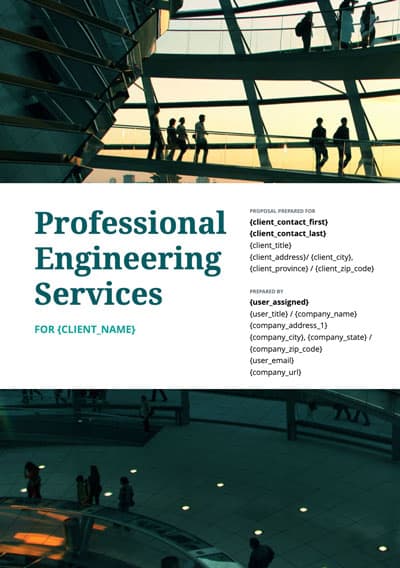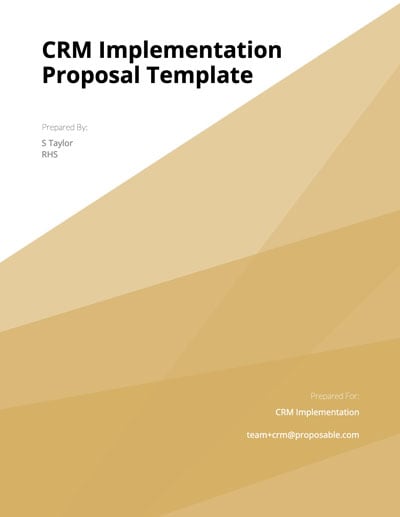How to Write A Winning Technical Proposal with Examples

Writing with AI - Learn more


Writing a technical proposal can feel like a daunting task, especially if you're unsure what exactly a technical proposal is or how to write a technical proposal clearly. You may wonder which components of a technical proposal are essential, how to organize the details, and how to make the content understandable for non-technical readers. Fortunately, technical proposal writing becomes much easier when you follow a consistent process.
Using a technical proposal format or even a simple technical proposal template can guide your structure and keep the message focused. In the sections that follow, we’ll break down the process into clear steps so you can confidently begin writing a technical proposal from start to finish.
A technical proposal is a persuasive document that outlines the technical requirements and details of a new project or service. Technical proposal writing involves turning technical information into an easy-to-understand document. It can include elements such as:
Our technical writing course is available for individuals and groups online, virtually, and onsite.
As an example, say that you're trying to convince a potential customer to purchase your company's cybersecurity software. You write a technical sales proposal that highlights the customer's problem, the benefits of solving it, and how your software is the best solution.
A technical proposal might also be internal and not a customer-facing external proposal. Maybe you are an engineer and have an idea for a new internal workflow project. You'd create an internal technical proposal covering the problem, solution, and plan to share with your boss.
Technical proposals can take different forms depending on the purpose, audience, and whether they are requested or self-initiated. Here are the 5 main types of proposals used:
Solicited Proposals are prepared in response to a specific request, such as a Request for Proposal (RFP), Request for Quotation (RFQ), or Request for Information (RFI) issued by a client or organization. Since the requirements are predefined, the proposal must strictly follow the client’s guidelines and address all stated needs.
These are created without a formal request from the client. They are often used to introduce a new idea, product, or service that the client may not have considered. Because they are unexpected, they must be persuasive and clearly demonstrate value to capture the client’s interest.
External Proposals are submitted to an entity outside the proposer’s organization, such as a government agency, business partner, or client. External proposals often require a high level of detail, professionalism, and compliance with industry or regulatory standards.
Internal Proposals are written for decision-makers within the same organization. They are often used to request funding, resources, or approval for internal projects, process improvements, or new initiatives. Since the audience is familiar with the organization, the focus is more on feasibility and return on investment.
This type is focused on offering products or services to potential clients. It highlights how the proposed solution meets the client’s needs while emphasizing competitive advantages, pricing, and benefits. These proposals are often designed to win contracts or sales agreements.
Writing a technical proposal requires a structured approach to ensure clarity, professionalism, and persuasiveness. A well-organized proposal not only explains the technical solution but also demonstrates feasibility, cost-effectiveness, and value to the clients. Below are the key steps to follow when creating one.
Contrary to what some proposal writers might think, don't start drafting a technical proposal right away. Planning the content first is crucial for efficiency and effectiveness.
First, ask yourself:
This information will impact your tone, language, the amount of detail you include, and more! In short, don't skip this step. Get an in-depth understanding of your reader's needs, wants, and preferences.
Once you have the answers, map out your content. What information will you include? What are your main points? Your subpoints? Creating an outline or concept map can help get your ideas on paper and speed up the actual writing process.
No matter if you're writing an informal email proposal or a formal Request for Proposals (RFP), proposals persuasively follow this overall structure:
Note: Notice how this structure doesn't start with an "About Us" section that details your company or who you are. Instead, it's audience-focused. It keeps the reader's needs and pain points in mind. It shows the reader that you have a deep understanding of their problem and can help.
You have your content plan to follow. Time to write the actual proposal. As you write the document, remember that your reader is the center of the action. Write to meet their needs and enhance their understanding.
Here are a few tips for creating a reader-focused proposal:
Persuasion is the name of the game in proposal writing. A thoughtful approach that centers around the reader will help you better persuade them to accept your proposal.
A proposal doesn't have to follow one specific format because each proposal depends on your reader's needs. However, there are three formats to consider:
Choose the style of your proposal based on what works best in each situation. Whatever style you choose, make sure to incorporate headings and bullets in your formatting. These elements help the reader skim and easily digest the information.
A sleek design with an eye-catching title page is also recommended.
Once you have your proposal written, time to edit for any mistakes.
Edit the substance first. Are there any technical concepts or sections that might confuse the reader? Is the information accurate? Once you've edited the substance, move on to the structure. Does it make logical sense for the reader? Finally, correct sentence structure and grammar.
After your first review, wait 24 hours and then review it again (and potentially again) before submitting the finished product.
Hint: We recommend using Grammarly to ensure that there are no careless grammar errors (e.g., missing punctuation) in your proposal.
Need some ideas for your proposal? Here are a few we analyzed that do a good job of persuading the reader to choose a company's product or service.

The Project Background sections clearly outline the work process for the client. Each task is clarified and seems to respond to the specifications of an RFP. It should follow the executive summary.
Critique: The introductory summary could include more persuasive and specific language. The Company Introduction and Team sections should also go towards the end of the proposal. Lead with the reader's pain points and benefits of overcoming the problem.

This customer-facing proposal breaks down the process for implementing the company's web design services. Financials are broken down by unit, hourly, and subscription costs, making it easy for the reader to absorb.
Critique: There are no clear financials or pricing details, which is often what clients are looking for in a proposal.

This proposal incorporates convincing language and bullet points to highlight the value of the CRM.
Critique: The About Us section should come after the benefit-to-client details. The language could also be improved. Instead of including general CRM best practices, the company could highlight what its CRM can specifically offer.
Discover more proposal examples here.
A technical proposal should not only solve a problem but also convince the reader that your approach is the best option. Strong proposals combine technical accuracy with clear, persuasive communication. Below are some valuable tips to help you write one effectively:
Technical information can be dense and difficult to process when presented only in text. Visuals such as flowcharts, diagrams, tables, or graphs make complex ideas easier to grasp. Breaking up long sections of text makes your proposal more reader-friendly. For example, a timeline shown as a Gantt chart is more effective than listing dates in a paragraph.
While technical proposals are written for experts, overusing jargon can create confusion, especially if decision-makers outside the technical team will review it. Use simple, precise language whenever possible. It is better to include technical terms that provide clear definitions. Overreliance on jargon can reduce clarity.
Every claim in your proposal should be supported with evidence. This can include statistics, case studies, pilot project results, or references to industry standards. Data builds credibility and demonstrates that your solution is not just theoretical but backed by proven results. For example, instead of saying “our system improves efficiency,” you could state, “our system reduces processing time by 30%, as shown in recent pilot testing.”
Clients and stakeholders value transparency. Provide detailed, step-by-step timelines and realistic budget estimates, rather than vague approximations. Unrealistic promises can damage trust if they are not achievable. A well-thought-out schedule and cost breakdown show that you’ve considered resource availability, risks, and contingencies.
Not all readers of a proposal will have the same background. A technical manager may want in-depth details about the methods, while executives may prefer a focus on costs, benefits, and strategic alignment. Always focus on your content, tone, and level of technical detail to suit the specific audience. This ensures that your proposal speaks directly to what matters most to the decision-makers.
In conclusion, writing a strong technical proposal requires clear planning, structured content, and a focus on the reader’s needs. By outlining the problem, emphasizing benefits, and presenting a well-formatted, error-free solution, you can transform technical details into a persuasive document. Whether internal or customer-facing, an effective proposal highlights value, builds trust, and increases acceptance, ultimately turning complex ideas into actionable solutions.
Take your technical writing skills to the next level by enrolling in a technical writing course. At Instructional Solutions, we offer online courses with comprehensive lessons, exercises, and individualized feedback to help new or experienced technical proposal writers. No matter your proposal assignment, Instructional Solutions helps you take an effective technical approach to writing and creating a successful proposal.
The purpose of a technical proposal is to present a clear, persuasive plan for solving a problem or delivering a service. It explains the scope, tasks, benefits, and costs, helping decision-makers understand why your solution is the best choice.
The length depends on the audience and purpose. A simple internal proposal could be just a few pages or even a well-structured email, while a formal response to an RFP may range from 10 to 50+ pages. The key is to be concise and include only necessary, relevant details.
A technical proposal focuses on technical details, processes, and solutions—often for projects, engineering, IT, or research. A business proposal, on the other hand, emphasizes commercial aspects like costs, business benefits, and ROI. A technical proposal may be part of a broader business proposal when both technical and financial details are required.
Yes, templates can save time and ensure consistency. However, they should be customized for the reader and project. A generic, copy-paste proposal can weaken your persuasiveness. Always tailor templates with specific details, benefits, and solutions for your audience.
When responding to an RFP, carefully follow the structure, format, and requirements outlined in the document. Address each specification directly, provide clear explanations of how your solution meets the needs, and include pricing or deliverables as requested. Ensure your proposal is complete, accurate, and aligned with the client’s expectations.
